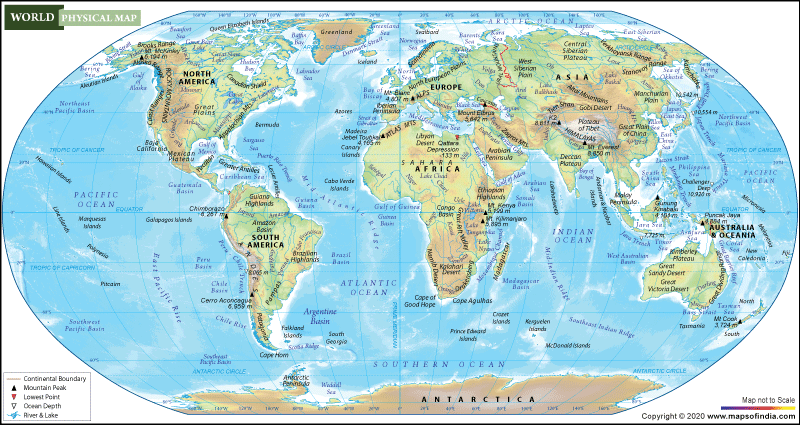The physical map of the world displays all the continents and various geographical features around the globe. Water bodies such as oceans, seas, lakes, rivers, and river basins, and landscape features such as plateaus, mountains, and deserts, are all displayed. The mountains shaded according to height, with the tallest mountain range in grey, and the oceans coloured according to depth, with the deepest ocean in blue, makes this physical map easy to comprehend visually. School children, who wish to increase their knowledge of world geography, will find this a valuable resource, as will teachers and parents.
Continents
The physical landmass of the world, i.e. of the planet Earth, is divided into seven continents. They are Africa, North America, South America, Europe, Australia, Asia and Antarctica (it being the only uninhabited continent). Asia, with 29% of the world landmass, is the largest and Australia with 5.9% of the landmass, the smallest. Mount Everest is the highest point on Earth and the Dead Sea the lowest.
Deserts
Deserts, places on Earth which have very little rainfall, can be either hot or cold. They occupy about 33% of the world landmass. The polar deserts of Antarctica and Arctic Circle are the largest cold deserts, and the Sahara and the Arabian Desert are the largest subtropical or hot deserts. Gobi and Kalahari are other large deserts.
Mountain ranges
Mountains cover 24% of the Earth's landmass and are spread over all the continents. Asia has the largest area covered with mountains and Africa the least with only 3%. The Himalayas, Earth's youngest mountains are also the highest. These mountains are still growing. Mount Everest at 8,848 metres is the highest peak and K2 at 8,611 metres, the second-highest. The Alps are the mountain ranges in Europe and Rockies in North America.
Oceans
Over two-thirds of the Earth's surface is covered with water, and of this, more than 97% of this water is in the oceans. The Pacific Ocean is the largest and deepest ocean in the world. The other oceans are Atlantic, Indian, Pacific, Southern and Arctic.
Lakes
The Earth is dotted with lakes - bodies of fresh or saltwater surrounded by a landmass. The northern hemisphere has the majority of freshwater lakes. The Aral Sea, Dead Sea, and the Great Salt Lake are saltwater lakes. The Caspian Sea, if considered as a lake, is the largest. Other large lakes are Lake Michigan in North America, Lake Victoria in Africa, and Lake Eyre in Australia.
Rivers
Rivers are watercourses flowing towards the oceans, seas, lakes or another river. The Nile River in Africa, which has a length of 6,695 kilometres, is the longest in the world. The Amazon, which is the second-largest river, is in South America. River Congo in Africa is the deepest river though it is the ninth longest. Other notable rivers are the Brahmaputra and the Ganges in Asia. Colorado and the Mississippi are rivers in North America.
Last Updated on: November 13, 2025
